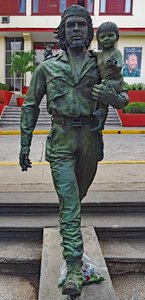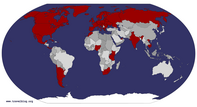Advertisement
Published: March 13th 2021

 Che Guevara
Che Guevara
Hero of Santa Clara History came a bit closer today. Our walking tour of
Santa Clara first led us to the state government building where Che Guevara strode strongly towards the street. Che was confidently carrying a young toddler in his arms, promising a supportive future. The larger-than-life bronze statue was embellished with small symbolic additions and insertions commemorating his legendary actions. The belt buckle was shaped as marchers in a triumphal parade. On his back was a low-relief figure showing an admiring woman leaning out of a window. Above her was a slot as in a piggy bank, expressing the trust the people had when he was the Minster of Finance after the revolution. One epaulette was a boy riding a goat, representing Che’s youth.
Santa Clara is known as Che’s town, in part because he met his second wife here, with whom he had three children. As we walked along the streets, we saw posters and bill boards praising Che, even more than is usual throughout the country. People hurried along conducting their business, buying things to eat and drink, and completing the usual tasks of life.
Where the railway crosses the main road (a train went by just before we did) is
a large park and outdoor museum. During the revolution, this was the site of a decisive action in the battle for Santa Clara, one of two simultaneous battles that forced Batista to flee Cuba. Kept informed by disgruntled workers at a Havana factory, the revolutionaries damaged the tracks with a Caterpillar tractor in preventing the movement of an armored troop train. Stymied, government troops on the train surrendered, which prevented them and other troop trains from reinforcing positions in eastern Cuba. (The revolutionaries had weapons and equipment mostly recovered after fights with the Batista regime.) The park and outdoor museum recreated the scene using toppled rail cars and askew concrete columns that simulated the crashing. As we looked at the photographs mounted inside the rail cars, a stirring ceremony was underway outdoors; we found out later that a new baseball team was being honoured.
Our tour continued through the ever-busier streets, and we admired the old colonial buildings. The route took us to the spacious, shady main square where lots of people sat on many benches. It was a wifi hot spot, highly prized for some. Others were just taking a few moments out of their day. We stepped
into the lobby of the Teatro de La Caridad, which was similar to the Terry Theatre in Cienfuegos. Again, a wealthy donor had funded the building in the late nineteenth century. Marta Abreu de Estévez was a great patron in the town, who used her wealth for civic improvements. Astonishingly, her philanthropy also funded the first electrical power plant, the scientific weather station, the train station, and more. Her statue facing the theatre is the only statue on the main square.
Also on the square was a large ornate lemon-yellow building, which was the public library. In our free time, I made a bee-line there. At first I stepped cautiously into the large lobby and reading room. To one side were additional rooms full of books. Surreptitiously, I took a few photos of the incredibly old and over-used books. A woman came in and chastised me, I thought for taking the photos, but she came back in another moment and shooed me out of the room altogether. Through gigantic windows open to the street, I saw Carolyn, and she let me know that there was a different entrance into another lobby. That lobby was surrounded by more rooms. Upstairs

 Glimpse into a reading room
Glimpse into a reading room
José Martí Provincial Library(I asked permission this time) were more rooms full of books, almost all stained brown with age and use. Fidel Castro strongly supported libraries, but probably the economy cannot support an infusion of new books.
After taking more photos around the square, there seemed to be enough time to find the dance school a few blocks away. I joined the throngs of people stepping on and off the sidewalks, by-passing obstructions and each other. Unexpectedly, what I did find was the Catedral de
Santa Clara de Asís, which proved to house a very plain interpretation of traditional Roman Catholic decoration. For example, what may have been the stations of the cross were small square crosses on the pillars with no numbers. The plainness of Catholic churches everywhere in Cuba may be due to the relative poverty of the adherents or could be the result of post-revolutionary policies. Daniel told us that 70%!o(MISSING)f the population identifies as Catholic, but younger generations do not necessarily attend church.
From the main square we walked a few blocks to a pretty restaurant, the La Alborada. In Cuba, words starting with “al” indicate a Moorish influence, coming from the time of the
Spanish conquest when crews and colonists were quite often Moors. The influence was very mild in this restaurant, except in having tall windows looking onto a garden courtyard where people could eat in warmer weather. We were all served salad starters, and for my main dish I had a delicious white-fish fillet. My dessert was a little guava-jam-turnover, part of the common plate of buns served with the meal. No local beer, so I had a Windmill, imported from Holland.
After lunch, we climbed into several “Bici Taxis”, a version of the bicycle rickshaw. The cart seemed to be made from welded pipes. In pairs we sat in the passenger seat behind the driver. We jounced along the streets, laughing and pointing out curiosities. The driver gave a modicum of commentary in basic English, since none of us had even basic Spanish.
Our destination was Loma del Carmen, the square commemorating the founding of the city in 1689 by coastal settlers looking for an escape from pirates. In this modern monument, each family was represented by a triangular pillar with the family name on a bronze plaque. A small attractive church was on one side of the monument,

 Bici Taxi tour drivers
Bici Taxi tour drivers
More fun than the bus, at least for a short distancenamed Iglesias del Carmen of course. After strolling around, we all switched Bici taxis to help even out the work for the driver/peddlers. (Some of us are heavier than others!) Bouncing along again, they took us to the Cathedral, where René had been able to (illegally) park the bus for a few minutes. We quickly changed conveyances.
">See my video of our Bici Taxi tour.
We drove to a huge park paved in cement and built of marble, where a gigantic statue of Che looks towards the future. His remains, and those of most of the 39 guerillas killed in Bolivia with him, are entombed in a mausoleum below. At the time of their death, the Bolivian dictatorship buried them as revolutionaries in unmarked graves, and it took thirty years of searching and scientific verification until the remains were returned to Santa Clara, their spiritual home. Entry into the mausoleum is designed to remind one of a cave, symbolizing the precarious life led by guerillas in any liberation war. Each niche is identified by the name and a relief of the face of a guerilla. Che’s is marked by a star in luminous paint. On the same level, is a museum of Che, showing his life
in photos and artifacts. Even when he was a little boy and a growing child, his face was fierce with determination. He was fiercely egalitarian, not just helping in the fields he visited as an official, but also angrily chastising political colleagues who took their status for granted. He looked happiest when he was surrounded by his comrades. “Che” is a nickname similar to “buddy” or “pal”. Che Guevara is revered as the greatest friend Cubans could ever have. He and Fidel were very good friends, trusting each other completely. Serving as Finance Minister after the revolution, Che decided his role was not to administer but to support other liberation forces, in countries as far afield as Zaire. Hostile arguments that he was pushed out of the regime were vehemently refuted by Daniel, who read us an English translation of Che’s farewell to Fidel.
Back at the hotel I cautiously ventured into the swimming pool. Since the sun was shining, the chilliness of the water did not deter me from swimming in the kidney-shaped pool. Carolyn got in just about when I got out. Gathering clouds quickly cooled the air.
cocktails by the pool; we retreated under canvas umbrellas to avoid the wind. A few days ago, he had asked if I would let him have the book I was reading before I left. Of course, I agreed and this evening brought down Iris Murdoch’s
, as well as two short Naguib Mahfouz novels I won’t have time to read. Despite his appreciativeness, I am not sure they will suit his taste. Still, finding English-language novels in a Spanish-speaking country must be difficult.
With an 8:00 departure tomorrow, we had dinner at the hotel buffet: pork ribs, delicious squash, ripe tomatoes and Crystal beer.



























Ake Och Emma
Ake Dahllof and Emma Holmbro
Good photo of the statue
You got a good photo of that statue, much better than the one I got. I also like the composite photo of the details. I am going to use that idea of displaying photos as composite pictures myself. I can see that it can be usseful. /Ake